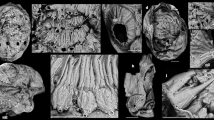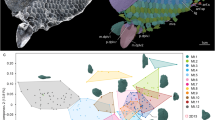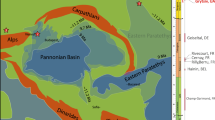Abstract
Stylophora are a peculiar extinct group of asymmetrical deuterostomes whose biological affinity has been fiercely debated1,2,3,4,5,6,7,8,9,10,11,12,13,14,15. Disarticulated skeletal elements of a ceratocystid stylophoran recovered from the earliest Middle Cambrian of Morocco are not only the oldest stylophorans in the fossil record, but their exceptional preservation provides crucial data on the microstructure of its skeleton. Stylophoran plates are constructed of a three-dimensional mesh, termed ‘stereom’, identical to that of living echinoderms in which stereom microstructure provides a reliable guide to the nature of the investing soft tissues16,17,18. Using modern echinoderm anatomy to interpret stereom microstructure of stylophoran elements, here we show that the large proximal lumen of their appendage was filled with muscle and that ligamentary tissues bound distal elements firmly together. We find no evidence for a mouth in the proximal lumen and no evidence that the covering plates of the appendage were articulated. Thus, although skeletal structure suggests that stylophorans are echinoderms, their appendage was not a feeding arm but a muscular locomotory organ.
This is a preview of subscription content, access via your institution
Access options
Subscribe to this journal
Receive 51 print issues and online access
$199.00 per year
only $3.90 per issue
Buy this article
- Purchase on Springer Link
- Instant access to full article PDF
Prices may be subject to local taxes which are calculated during checkout




Similar content being viewed by others
References
Bather, F. A. A class of Echinoderma without trace of radiate symmetry. Arch. Zool. Ital. 14, 431–439 (1930)
Philip, G. M. Carpoids—echinoderms or chordates? Biol. Rev. 54, 439–471 (1979)
Kolata, D. R., Frest, T. J. & Mapes, R. H. The youngest carpoid: occurrence, affinities and life mode of a Pennsylvanian (Morrowan) mitrate from Oklahoma. J. Paleontol. 65, 844–855 (1991)
Gee, H. Before the Backbone: Views on the Origin of the Vertebrates (Chapman & Hall, London, 1996)
Smith, A. B. The preradial history of echinoderms. Geol. J. 40, 255–280 (2004)
Ubaghs, G. in Treatise on Invertebrate Paleontology part S Echinodermata 1 (ed. Moore, R. C.) 495–565 (Geological Society of America and Univ. Kansas Press, Boulder, Colorado, 1968)
Parsley, R. L. in Echinoderm Phylogeny and Evolutionary Biology (eds Paul, C. R. C. & Smith, A. B.) 345–361 (Clarendon, Oxford, 1988)
Sprinkle, J. in Origin and Early Evolution of Metazoa (eds Lipps, J. H. & Signor, P. W.) 375–398 (Plenum, New York, 1992)
Jefferies, R. P. S. Some fossil chordates with echinoderm affinities. Symp. Zool. Soc. Lond. 20, 163–208 (1967)
Jefferies, R. P. S. The Ancestry of the Vertebrates (British Museum, Natural History, London, 1986)
Cripps, A. P. A cladistic analysis of the cornutes (stem chordates). Zool. J. Linn. Soc. 102, 333–366 (1991)
Jefferies, R. P. S., Brown, N. A. & Daley, P. E. J. The early phylogeny of chordates and echinoderms and the origin of chordate left-right asymmetry and bilateral symmetry. Acta Zool. 77, 101–122 (1996)
Sumrall, C. D. The role of fossils in the phylogenetic reconstruction of Echinodermata. Paleontol. Soc. Pap. 3, 267–288 (1997)
David, B., Lefebvre, B., Mooi, R. & Parsley, R. Are homalozoans echinoderms? An answer from the extraxial–axial theory. Paleobiology 26, 529–555 (2000)
Lefebvre, B. Functional morphology of stylophoran echinoderms. Palaeontology 46, 511–555 (2003)
Roux, M. Microstructural analysis of the crinoid stem. Paleontol. Contrib. Univ. Kansas 75, 1–7 (1975)
Smith, A. B. Stereom microstructure of the echinoid test. Spec. Pap. Palaeontol. 25, 1–81 (1980)
Smith, A. B. in Skeletal Biomineralization: Patterns, Processes, and Evolutionary Trends (ed. Carter, J. G.) 413–443 (Van Nostrand Reinhold, New York, 1990)
Álvaro, J. J. The Lower-Middle Cambrian Transition in the Western Mediterranean Region: Biodiversity and Paleogeographic Patterns. Thesis, Univ. Lille 1 (2002)
Clausen, S. The Non-reefal Echinoderm-sponge Meadows of the Lower-Middle Cambrian Transition in the Western Mediterranean Region. Thesis, Univ. Lille 1 (2004)
Geyer, G. & Landing, E. The Cambrian of the Moroccan Atlas regions. Beringeria 2 (special issue), 7–46 (1995)
Berg-Madsen, V. Middle Cambrian cystoid (sensu lato) columnals from Bornholm. Denmark. Lethaia 19, 67–80 (1986)
Ubaghs, G. Le genre Ceratocystis Jaekel (Echinodermata, Stylophora). Paleontol. Contrib. Univ. Kansas 30, 1–16 (1967)
Sumrall, C. D. & Bowsher, A. L. Gigantoclavus, a new genus of Pennsylvanian edrioasteroid from North America. J. Paleontol. 70, 986–993 (1996)
Benito, J. & Pardos, F. in Microscopic Anatomy of Invertebrates vol. 15 Hemichordata, Chaetognatha, and the Invertebrate Chordates (eds Harrison, F. W. & Ruppert, E. E.) 15–102 (Wiley-Liss, New York, 1997)
Brower, J. C. A new pleurocystitid rhombiferan echinoderm from the Middle Ordovician Galena Group of northern Iowa and southern Minnesota. J. Paleontol. 73, 129–153 (1999)
Acknowledgements
The authors thank J. J. Álvaro for comments on an earlier draft of this paper. Funding was provided by High Lat resources through the European Commission's Access to Research Infrastructure action of the Improving Human Potential Programme and the Swedish Museum of Natural History. Author Contributions The two authors contributed equally to this paper.
Author information
Authors and Affiliations
Corresponding author
Ethics declarations
Competing interests
Reprints and permissions information is available at npg.nature.com/reprintsandpermissions. The authors declare no competing financial interests.
Supplementary information
Supplementary Table
Stereoms present in the stylocone and distal ossicles of Ceratocystis. (DOC 24 kb)
Rights and permissions
About this article
Cite this article
Clausen, S., Smith, A. Palaeoanatomy and biological affinities of a Cambrian deuterostome (Stylophora). Nature 438, 351–354 (2005). https://doi.org/10.1038/nature04109
Received:
Accepted:
Issue Date:
DOI: https://doi.org/10.1038/nature04109
This article is cited by
-
A stem group echinoderm from the basal Cambrian of China and the origins of Ambulacraria
Nature Communications (2019)
-
Roles of retinoic acid and Tbx1/10 in pharyngeal segmentation: amphioxus and the ancestral chordate condition
EvoDevo (2014)
-
Reassessing the improbability of a muscular crinoid stem
Scientific Reports (2014)
-
The oldest echinoderm faunas from Gondwana show that echinoderm body plan diversification was rapid
Nature Communications (2013)
-
Stereom microstructure of columnal latera: a character for assessing phylogenetic relationships in articulate crinoids
Swiss Journal of Palaeontology (2011)
Comments
By submitting a comment you agree to abide by our Terms and Community Guidelines. If you find something abusive or that does not comply with our terms or guidelines please flag it as inappropriate.



